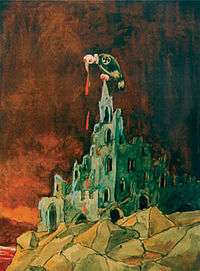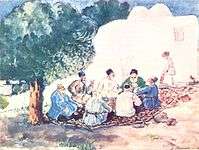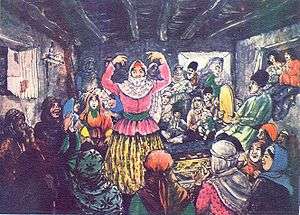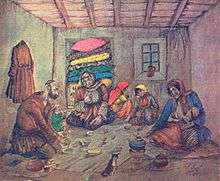Azim Azimzade
| Əzim Əzimzadə | |
|---|---|
 | |
| Born |
Əzim Aslan oğlu Əzimzadə 7 May 1880 Novxanı, Baku Governorate, Russian Empire |
| Died |
15 June 1943 (aged 63) Baku, Azerbaijan |
| Nationality | Azerbaijani |
| Known for | Artist, Caricaturist |
Azim Aslan oglu Azimzade (Azerbaijani: Əzim Aslan oğlu Əzimzadə; 7 May 1880 – 15 June 1943) was an Azerbaijani artist and cartoonist. He was awarded the honorary title of People's Artist of the Azerbaijan SSR.[1][2]
Biography


Azim Azimzade was born into the family of an oil industry worker at Novxanı village in the Baku Governorate of the Russian Empire (present-day Azerbaijan) in 1880.[1][2][3] He received no artistic education and was self-educated.[1][4] Beginning in 1906, he published paintings concerning social and political issues in magazines. Due to that Azim Azimzade became the founder of Azerbaijani satirical graphics. Azim Azimzade actively participated in revolution, was the manager of culture department of enlightenment of People’s Commissariat of Azerbaijan.
Azimzade’s creativity was multisided. After the revolution he was engaged in book and easel graphics. His heritage consists of easel sheets, book illustrations, paintings from satirical magazines and newspapers, drafts of costumes and decorations, political caricatures and posters. Traditions of realistic satirical graphic of “Molla Nasraddin” magazine and other pre-revolutionary humorous magazines, in which Azimzade actively worked, were successfully used by him for creation of new works of poster arts.[5] Nearly half of all posters of Azimzade were dedicated to anti-religious themes. Patterns of his posters were evoked by real personages, taken from the artist’s modern reality. One of Azimzade’s posters, published in 1925, portrays a peasant with a fork, throwing a plunderer of nation’s property away from village. Azim Azimzade’s posters not only castigated remains of the past, they also portrayed images of positive heroes, too. The artist was mostly interested in the image of hero-man and his psychological characteristics. The first posters of Azim Azimzade were exhibited in Moscow, in 1933, on the exhibition of Azerbaijani artists. They were highly evaluated by central press.
Caricatures took an important place in creative heritage of Azim Azimzade. Development of this genre is closely related to “Molla Nasraddin” magazine. The magazine passed an interesting creative way during its existence period for many years (1906–1931). The first issue of a magazine was released in Tbilisi, in April 1906. Its publisher was a talented writer-publicist Jalil Mammadguluzadeh, who took the Eastern wise man Molla Nasraddin’s name as a pseudonym. “Molla Nasraddin” was the first satiric magazine in whole Muslim East at that time. It was created under the influence of liberation ideas of the first Russian revolution of 1905. After the revolution, from 1922, “Molla Nasraddin” magazine’s edition was renewed. From this period began the productive cooperation of Jalil Mammadguluzadeh with Azim Azimzade. Azim Azimzade became the chief artist of “Molla Nasraddin”.[6] His creativity determined artistic character of the magazine, where his paintings and caricatures took an important place. He could notice subtly and accurately transmitted gestures, motions, poses of his personages.
Azim Azimzade created 56 colored lithographs for collected works of People’s poet M.A.Sabir’s “Hop-hop name”.[7] These paintings revealed ideological essence of the poet’s works, his protest against social unfairness and oppression of workers, against obscurantism. Azimzade also created such bright and expressive series of pictures to stories as “Maybe they’ll return” of Jalil Mammadguluzadeh, “My deer” of A.Hagverdiyev, “Sanctuary” of N.Narimanov, for H.Sarabski’s “Old Balu” book and for other literary works. Azim Azimzade’s illustrations for A.Hagverdiyev’s “Letters from hell” narrative created images of inhabitants of the “hell” – symbolic gathering of negative types.
In 1927, Azim Azimzade created colorful illustrations for fairytales for children in “Wild ox” poems of G.K.Sanily. In 1937, an album “Shadows of the past” with 26 paintings, locating in double-page spreads of pages was published. In these pictures the author revealed scenes before spectators from provincial life of a capitalist city, saving features of feudal relations.
In 1930’s, thematic series with plot consist the main part of the artist’s creativity. The best genre watercolors of Azim Azimzade are “Scenes of old life”, “Ramadan of the rich people”, “Ramadan of the poor people”, “Wedding of the rich people”, “Wedding of the poor people”, “Dog baiting”, “Daughter was born”, “Purchase of wife”, “Old wife and a new one”, “Husband beating his wife” and others. Emotionality of many lists of Azimzade depends on successful color resolution. Color of his watercolors gives a good mood, simplifies perception of depicted scene.
In watercolors describing everyday life, such as “Kos-kosa” (humoristic folk performance), “Jumping over bonfire”, “Separation of property”, “Rope walker”, “Puppet theatre” were shown customs of that time. In such compositions as “Wedding of the rich people” and “Wedding of the poor people” Azimzade reveals the idea of social inequality by means of contrasting confrontation of everyday life’s peculiarities, wedding ceremonies and religious holidays at different classes of the society.
From the first days of the war (1941–1945) Azimzade, like a lot of Soviet artists actively participated in creation of “Agitokon” posters, which were driving feature of battle and political agitation. Colorful, accurate and laconic “Agitokon”s were filled with words in Azerbaijani and Russian languages. In the work on posters such writers and poets as S.Rahman, Y.Fidler, G.Stroganov, M.Seyidzade, N.Rafibeyli and others worked together with artists. During first two years of the war Azim Azimzade created more than 50 caricatures. Antifaschist caricatures of Azim Azimzade represented new period of development of the artist’s creativity. Considering the importance of political satire during the wartime Azimzade limitedly sharpened methods of caricature, strengthened perception of color. Small number of personages portrayed on close shot against a clean background of paper distinguishes these paintings from prewar works of historical and everyday life themes with their difficult multifigured compositions.
Most popular caricatures were “Lion and kitten”, “Face of fascism”, “Trophies of Führer”, “Delusion of grandeur”, “Trumped cards”, “Watchdogs of imperialism”, “Shadows of barbarians”, “Wolf to wolf”, “Inevitable guests of fascist Germany” and others. In “Lion and kitten” (1941) caricature Hitler was ridiculed, comparing himself with Napoleon. There is inscription on the lion’s back: “Battle of Borodino”, on the head bandage with words: “Moscow, 1812”. Martial courage of the cat said that, he learnt nothing from the lion’s defeat. In “Trumped cards” (1942) cards were thrown on green pigeonhole of playing table in disorder, on which were portrayed Hitler and his fellow fighters with a little bit likeness.
With his creativity Azim Azimzade made a great contribution to development of the Soviet antifascist caricature of wartime. In 1942, continuing his work in the sphere of book graphics Azim Azimzade created colorful illustrations to folktale “Khoruz” (Cock), in which was narrated about the cheerful cock, which triumphed shah. Azim Azimzade won’t live till the Great Victory – he died in the prime of his life in 1943, at the age of 63.
In 1923, he became a member of the CPSU. In 1927, Azimzade was awarded an honorary title of People’s Artist of the Azerbaijan SSR.[8] It is considered that Azimzade evaded political repressions due to his acquaintance with Mir Jafar Baghirov, the first secretary of the Azerbaijan Communist Party, who was admirer of the artist’s creativity.[9]
In Baku was opened home-museum of the artist.[10][11] Street in Baku and Artistic School of Azerbaijan, where he taught from 1920 till the end of his life and from 1932 till 1937 was its director were named after him[12] and a museum is dedicated to his works.[13][14] In 2002, a monument to the artist was erected near Heydar Aliyev Palace, in Baku.
Gallery
-
The Twentieth Century, a 1910 cartoon, representing Europe and Japan as prosperous developed civilizations and Asia as land of slackers and the oppressed lower class. The comment in Azeri reads: "The state of the continents in the twentieth century". 1910
-

Caricature in "Molla Nasreddin" satirical magazine. 1906
-

Cockfighting. 1915
-

Folk performance Kos-Kosa.jpg. 1930
-

At Baku summer cottages. 1931
-

The color of claret belongs to us. 1931
-

Wedding of the poor people. 1931
-

Old wife and a new one. 1935
-

Jumping over bonfire. 1937
-

The girl was born. 1937
-

Dog baiting. 1938
-

Ramadan of the rich people. 1932
-

Ramadan of the poor people. 1938
-

Execution of poet Nasimi
References
| Wikimedia Commons has media related to Azim Azimzade. |
- 1 2 3 Aliyev, Ziyadkhan, "Baku's Art School Named After Self-Taught Artist", Azerbaijan International, retrieved 9 February 2010
- 1 2 Horn, Maurice (1983), The World Encyclopedia of Cartoons, Chelsea House Publishers, p. 94, ISBN 0-87754-399-2
- ↑ "Высокое имя Азим Азимзаде – ОЧЕРК – ФОТО". 1news.az. Archived from the original on 4 May 2011.
- ↑ "Талантливый самоучка". 1news.az. Archived from the original on 4 May 2011.
- ↑ "Высокое имя Азим Азимзаде". 1news.az. Archived from the original on 4 May 2011.
- ↑ "Вспоминая Азима Азимзаде". Archived from the original on 8 October 2011.
- ↑ "Высокое имя Азим Азимзаде". 1news.az. Archived from the original on 4 May 2011.
- ↑ "Высокое имя Азим Азимзаде". 1news.az. Archived from the original on 4 May 2011.
- ↑ "Как азербайджанский художник Азим Азимзаде спасся от репрессий тридцатых годов". Trend.az. 30 April 2009.
- ↑ "В Баку состоится "Вечер Азима Азимзаде"". Trend.az.
- ↑ "Высокое имя Азим Азимзаде". 1news.az. Archived from the original on 4 May 2011.
- ↑ Huseinov, Orkhan, "Old Baku on Canvas: The Imaginative World of Orkhan Huseinov", Azerbaijan International, retrieved 10 February 2010
- ↑ "Baku to launch project of mobile exhibitions museums", News.Az, 4 February 2010, archived from the original on 10 February 2010, retrieved 10 February 2010
- ↑ "Websites of seven Azerbaijan-based museums presented", Azerbaijan Press Agency, 12 October 2009, archived from the original on 7 April 2012, retrieved 9 February 2010